Assessing the Performance of the WRF Model in Simulating Squall Line Processes over the South African Highveld †
Abstract
1. Introduction
2. Data and Methods
2.1. Study Area
2.2. Case Study Selection
2.3. Synoptic Analysis
2.4. Model and Simulation Description
2.5. Model Verification
3. Event Description
3.1. Case 1: 21 October 2017 Squall Line (Afternoon Case)
3.2. Case 2: 31 January 2018/1 February 2018 Squall Line (Midnight Case)
4. Results and Discussions
4.1. Radar Analysis
4.2. Verification Statistics
4.3. Circulation Analysis: Observations Versus WRF Simulations of the Two Squall Lines
4.4. Observed Versus Simulated Rainfall
5. Summary and Conclusions
Author Contributions
Funding
Institutional Review Board Statement
Informed Consent Statement
Data Availability Statement
Acknowledgments
Conflicts of Interest
References
- Harrison, M.S.J. The annual rainfall cycle over the central interior of South Africa. S. Afr. Geogr. J. 1984, 66, 47–64. [Google Scholar] [CrossRef]
- Tyson, P.D.; Preston-Whyte, R.A. The Weather and Climate of Southern Africa; Oxford University Press: Oxford, UK, 2000; 396p. [Google Scholar]
- Hart, N.C.G.; Reason, C.J.C.; Fauchereau, N. Cloud bands over southern Africa: Seasonality, contribution to rainfall variability and modulation by the MJO. Clim. Dyn. 2013, 41, 1199–1212. [Google Scholar] [CrossRef]
- Singleton, A.T.; Reason, C.J.C. Variability in the characteristics of cut-off low pressure systems over subtropical southern Africa. Int. J. Climatol. 2007, 27, 295–310. [Google Scholar] [CrossRef]
- Favre, A.; Hewitson, B.; Lennard, C.; Cerezo-Mota, R.; Tadross, M. Cut-off lows in the South Africa region and their contribution to precipitation. Clim. Dyn. 2013, 41, 2331–2351. [Google Scholar] [CrossRef]
- Xulu, N.G.; Chikoore, H.; Bopape, M.-J.M.; Ndarana, T.; Muofhe, T.P.; Mbokodo, I.L.; Munyai, R.B.; Singo, M.V.; Mohomi, T.; Mbatha, S.M.S.; et al. Cut-off lows over South Africa: A review. Climate 2023, 11, 59. [Google Scholar] [CrossRef]
- Schefczyk, L.; Heinemann, G. Climate change impact on thunderstorms: Analysis of thunderstorm indices using high-resolution regional climate simulations. Meteorol. Z. 2017, 26, 409–419. [Google Scholar] [CrossRef]
- STATSSA. Census 2022 Results. 2023. Available online: www.statssa.gov.za/wp-content/uploads/2023/10/Mbalo-brief-October-2023-WEB-FINAL.pdf (accessed on 25 January 2023).
- Kruger, A.C.; Shongwe, S. Temperature trends in South Africa: 1960–2003. Int. J. Clim. 2004, 24, 1929–1945. [Google Scholar] [CrossRef]
- Berg, P.; Moseley, C.; Haerter, J.O. Strong increase in convective precipitation in response to higher temperatures. Nat. Geosci. 2013, 6, 181–185. [Google Scholar] [CrossRef]
- Brooks, H.E. Severe thunderstorms and climate change. Atmos. Res. 2013, 123, 129–138. [Google Scholar] [CrossRef]
- Maure, G.; Pinto, I.; Ndebele-Murisa, M.; Lennard, C.; Nikulin, G.; Dosio, A.; Meque, A. The southern African Climate under 1.5 and 2 degree of global warming as simulated by CORDEX Regional Climate Models. Environ. Res. Lett. 2018, 13, 065002. [Google Scholar] [CrossRef]
- Kruger, A.C.; Rautenbach, H.; Mbatha, S.; Ngwenya, S.; Makgoale, T.E. Historical and projected trends in near-surface temperature indices for 22 locations in South Africa. S. Afr. J. Sci. 2019, 115, 50–58. [Google Scholar] [CrossRef] [PubMed]
- Intergovernmental Panel on Climate Change (IPCC). Linking Global to Regional Climate Change. Climate Change 2021—The Physical Science Basis; Intergovernmental Panel on Climate Change (IPCC): Geneva, Switzerland, 2023. [Google Scholar]
- Blamey, R.C.; Reason, C.J.C. Numerical simulation of a mesoscale convective system over the east coast of South Africa. Tellus A Dyn. Meteorol. Oceanogr. 2009, 61, 17–34. [Google Scholar] [CrossRef][Green Version]
- Crétat, J.; Pohl, B. How physical parameterizations can modulate internal variability in a regional climate model. J. Atmos. Sci. 2012, 69, 714–724. [Google Scholar] [CrossRef]
- Crétat, J.; Macron, C.; Pohl, B.; Richard, Y. Quantifying internal variability in a regional climate model: A case study for Southern Africa. Clim. Dyn. 2011, 37, 1335–1356. [Google Scholar] [CrossRef]
- Ratnam, J.V.; Behera, S.K.; Masumoto, Y.; Takahashi, K.; Yamagata, T. A simple regional coupled model experiment for summer-time climate simulation over southern Africa. Clim. Dyn. 2011, 39, 2207–2217. [Google Scholar] [CrossRef]
- Landman, S. A Multi-Model Ensemble System for Short-Range Weather Prediction in South Africa. Master’s Thesis, University of Pretoria, Pretoria, South Africa, 2012; 132p. [Google Scholar]
- Blamey, R.C.; Reason, C.J.C. Mesoscale convective complexes over southern Africa. J. Clim. 2012, 25, 753–766. [Google Scholar] [CrossRef][Green Version]
- Houze, R.A., Jr. Cloud Dynamics; Academic Press: Cambridge, MA, USA, 1993; 573p. [Google Scholar]
- Houze, R.A., Jr. Mesoscale convective systems. Rev. Geophys. 2004, 42, RG4003. [Google Scholar] [CrossRef]
- Thurai, M.; Bringi, V.; Wolff, D.; Marks, D.; Pabla, C. Testing the drop-size distribution-based separation of stratiform and convective rain using radar and disdrometer data from a mid-latitude coastal region. Atmosphere 2021, 12, 392. [Google Scholar] [CrossRef]
- Maddox, R.A. Mesoscale convective complexes. Bull. Am. Meteorol. Soc. 1980, 61, 1374–1387. [Google Scholar] [CrossRef]
- Thoithi, W.; Blamey, R.; Reason, C. The contribution of mesoscale weather systems to extreme rainfall over the coast of southeastern Africa: The April 2022 event. In Proceedings of the XXVIII General Assembly of the International Union of Geodesy and Geophysics (IUGG), Berlin, Germany, 11–20 July 2023; GFZ German Research Centre for Geosciences: Potsdam, Germany, 2023. [Google Scholar]
- Lilly, D.K. The dynamical structure and evolution of thunderstorms and squall lines. Annu. Rev. Earth Planet. Sci. 1979, 7, 117–161. [Google Scholar] [CrossRef]
- Lu, Y.; Ozaki, M. 2015S-GS18-5 Research on Squall Line and the Effects on Offshore Operation During its Passage. In Conference Proceedings the Japan Society of Naval Architects and Ocean Engineers; The Japan Society of Naval Architects and Ocean Engineers: Tokyo, Japan, 2015; Volume 20, pp. 461–464. [Google Scholar]
- Yang, H.-L.; Xiao, H.; Guo, C.-W. Structure and evolution of a squall line in northern China: A case study. Atmos. Res. 2015, 158–159, 139–157. [Google Scholar] [CrossRef]
- Sousa, A.C.; Candido, L.A.; Satyamurty, P. Convective cloud clusters and squall lines along the coastal Amazon. Mon. Weather. Rev. 2021, 149, 3589–3608. [Google Scholar] [CrossRef]
- Rutledge, S.A.; MacGorman, D.R. Cloud-to-ground lightning activity in the 10–11 June 1985 mesoscale convective system observed during the Oklahoma–Kansas PRE-STORM project. Mon. Weather. Rev. 1988, 116, 1393–1408. [Google Scholar] [CrossRef]
- Gill, T. Initial Steps in the Development of a Comprehensive Lightning Climatology of South Africa. Master’s Thesis, University of the Witwatersrand, Johannesburg, South Africa, 2009. [Google Scholar]
- Panda, J.; Paul, D.; Sarkar, A.; Mukherjee, A.; Bhasi, I.; Tom, G.; Das, S.; Lohan, N.; Roy, D.; Kumar, S. Severe Storms in Changing Climate Scenario with a Distinctive Emphasis on South Asia and India. In Severe Storms: Anatomy, Early Warning Systems and Aftermath in Changing Climate Scenarios; Springer: Singapore, 2025; pp. 563–606. [Google Scholar]
- Dyson, L.L., Jr.; van Heerden, J.; Sumner, P.D. A baseline climatology of sounding--derived parameters associated with heavy rainfall over Gauteng, South Africa. Int. J. Clim. 2015, 35, 114–127. [Google Scholar] [CrossRef]
- Skamarock, W.C.; Klemp, J.B.; Dudhia, J.; Gill, D.O.; Barker, D.M.; Duda, M.G.; Huang, X.Y.; Wang, W.; Powers, J.G. A Description of the Advanced Research WRF Version 3; NCAR Technical Note; National Center for Atmospheric Research: Boulder, CO, USA, 2008; Volume 475, pp. 10–5065. [Google Scholar]
- Skamarock, W.C.; Klemp, J.B.; Dudhia, J.; Gill, D.O.; Liu, Z.; Berner, J.; Wang, W.; Powers, J.G.; Duda, M.G.; Barker, D.M.; et al. A Description of the Advanced Research WRF Version 4; NCAR Technical Note ncar/tn-556+str; National Center for Atmospheric Research: Boulder, CO, USA, 2019; p. 145. [Google Scholar]
- Ratna, S.B.; Ratnam, J.V.; Behera, S.K.; Rautenbach, C.J.D.; Ndarana, T.; Takahashi, K.; Yamagata, T. Performance assessment of three convective parameterization schemes in WRF for downscaling summer rainfall over South Africa. Clim. Dyn. 2014, 42, 2931–2953. [Google Scholar] [CrossRef]
- Maisha, T.R. The influence of topography and model grid resolution on extreme weather forecasts over South Africa. Master’s Thesis, University of Pretoria, Pretoria, South Africa, 2014. [Google Scholar]
- Ratnam, J.V.; Doi, T.; Landman, W.A.; Behera, S.K. Seasonal forecasting of onset of summer rains over South Africa. J. Appl. Meteorol. Clim. 2018, 57, 2697–2711. [Google Scholar] [CrossRef]
- Khain, A.P.; Beheng, K.D.; Heymsfield, A.; Korolev, A.; Krichak, S.O.; Levin, Z.; Pinsky, M.; Phillips, V.; Prabhakaran, T.; Teller, A.; et al. Representation of microphysical processes in cloud--resolving models: Spectral (bin) microphysics versus bulk parameterization. Rev. Geophys. 2015, 53, 247–322. [Google Scholar] [CrossRef]
- Morrison, H.; Milbrandt, J.A. Parameterization of cloud microphysics based on the prediction of bulk ice particle properties. Part I: Scheme description and idealized tests. J. Atmos. Sci. 2015, 72, 287–311. [Google Scholar] [CrossRef]
- Köcher, G.; Zinner, T.; Knote, C. Influence of cloud microphysics schemes on weather model predictions of heavy precipitation. Atmos. Chem. Phys. Discuss. 2023, 23, 6255–6269. [Google Scholar] [CrossRef]
- Gallus, W.A., Jr.; Pfeifer, M. Intercomparison of simulations using 5 WRF microphysical schemes with dual-polarization data for a German squall line. Adv. Geosci. 2008, 16, 109–116. [Google Scholar] [CrossRef]
- Morrison, H.; Thompson, G.; Tatarskii, V. Impact of cloud microphysics on the development of trailing stratiform precip-itation in a simulated squall line: Comparison of one-and two-moment schemes. Mon. Weather. Rev. 2009, 137, 991–1007. [Google Scholar] [CrossRef]
- Hong, S.-Y.; Lim, K.-S.S.; Lee, Y.-H.; Ha, J.-C.; Kim, H.-W.; Ham, S.-J.; Dudhia, J. Evaluation of the WRF double-moment 6-class microphysics scheme for precipitating convection. Adv. Meteorol. 2010, 2010, 707253. [Google Scholar] [CrossRef]
- Wu, D.; Dong, X.; Xi, B.; Feng, Z.; Kennedy, A.; Mullendore, G.; Gilmore, M.; Tao, W.-K. Impacts of microphysical scheme on convective and stratiform characteristics in two high precipitation squall line events. J. Geophys. Res. Atmos. 2013, 118, 11119–11135. [Google Scholar] [CrossRef]
- Fridlind, A.M.; Li, X.; Wu, D.; van Lier-Walqui, M.; Ackerman, A.S.; Tao, W.-K.; McFarquhar, G.M.; Wu, W.; Dong, X.; Wang, J.; et al. Derivation of aerosol profiles for MC3E convection studies and use in simulations of the 20 May squall line case. Atmos. Meas. Tech. 2017, 17, 5947–5972. [Google Scholar] [CrossRef]
- Karimkhani, M.; Azadi, M.; Meshkatee, A.H.; Saadatabadi, A.R. Evaluation of WRF microphysics schemes in the simulation of a squall line over IRAN using radar and reanalysis data. Nexo Rev. Cient. 2021, 34, 682–697. [Google Scholar] [CrossRef]
- Meroni, A.N.; Oundo, K.A.; Muita, R.; Bopape, M.-J.; Maisha, T.R.; Lagasio, M.; Parodi, A.; Venuti, G. Sensitivity of some African heavy rainfall events to microphysics and planetary boundary layer schemes: Impacts on localised storms. Q. J. R. Meteorol. Soc. 2021, 147, 2448–2468. [Google Scholar] [CrossRef]
- Bopape, M.-J.M.; Engelbrecht, F.A.; Maisha, R.; Chikoore, H.; Ndarana, T.; Lekoloane, L.; Thatcher, M.; Mulovhedzi, P.T.; Rambuwani, G.T.; Barnes, M.A.; et al. Rainfall Simulations of High-Impact Weather in South Africa with the Conformal Cubic Atmospheric Model (CCAM). Atmosphere 2022, 13, 1987. [Google Scholar] [CrossRef]
- Lin, Y.L.; Farley, R.D.; Orville, H.D. Bulk parameterization of the snow field in a cloud model. J. Appl. Meteorol. Climatol. 1983, 22, 1065–1092. [Google Scholar] [CrossRef]
- Thompson, G.; Rasmussen, R.M.; Manning, K. Explicit forecasts of winter precipitation using an improved bulk microphysics scheme. Part I: Description and sensitivity analysis. Mon. Weather. Rev. 2004, 132, 519–542. [Google Scholar] [CrossRef]
- Hong, S.Y.; Dudhia, J.; Chen, S.H. A revised approach to ice microphysical processes for the bulk parameterization of clouds and precipitation. Mon. Weather. Rev. 2004, 132, 103–120. [Google Scholar] [CrossRef]
- Lim, K.-S.S.; Hong, S.-Y. Development of an effective double-moment cloud microphysics scheme with prognostic cloud condensation nuclei (CCN) for weather and climate models. Mon. Weather. Rev. 2010, 138, 1587–1612. [Google Scholar] [CrossRef]
- Fan, J.; Han, B.; Varble, A.; Morrison, H.; North, K.; Kollias, P.; Chen, B.; Dong, X.; Giangrande, S.E.; Khain, A.; et al. Cloud—Resolving model intercomparison of an MC3E squall line case: Part I—Convective updrafts. J. Geophys. Res. Atmos. 2017, 122, 9351–9378. [Google Scholar] [CrossRef]
- Han, B.; Fan, J.; Varble, A.; Morrison, H.; Williams, C.R.; Chen, B.; Dong, X.; Giangrande, S.E.; Khain, A.; Mansell, E.; et al. Cloud—Resolving model intercomparison of an MC3E squall line case: Part II. Stratiform precipitation properties. J. Geophys. Res. Atmos. 2019, 124, 1090–1117. [Google Scholar] [CrossRef]
- McCumber, M.; Tao, W.-K.; Simpson, J.; Penc, R.; Soong, S.-T. Comparison of ice-phase microphysical parameterization schemes using numerical simulations of tropical convection. J. Appl. Meteorol. Clim. 1991, 30, 985–1004. [Google Scholar] [CrossRef]
- Carte, A.E.; Held, G. Variability of hailstorms on the South African Plateau. J. Appl. Meteorol. 1978, 17, 365–373. [Google Scholar] [CrossRef][Green Version]
- Gijben, M. The lightning climatology of South Africa. S. Afr. J. Sci. 2012, 108, 1–10. [Google Scholar] [CrossRef]
- van Schalkwyk, L.; Blamey, R.C.; Dyson, L.L.; Reason, C.J.C. A climatology of drylines in the interior of subtropical southern Africa. J. Clim. 2022, 35, 6411–6430. [Google Scholar] [CrossRef]
- Liesker, C.G.; Dyson, L.L.; Becker, E.H. Characteristics of warm season left-moving supercells over the Highveld of South Africa. Atmos. Res. 2024, 300, 107234. [Google Scholar] [CrossRef]
- Tesfaye, M.; Sivakumar, V.; Botai, J.; Mengistu Tsidu, G. Aerosol climatology over South Africa based on 10 years of Mul-tiangle Imaging Spectroradiometer (MISR) data. J. Geophys. Res. 2011, 116, D20216. [Google Scholar] [CrossRef]
- D’ABreton, P.C.; Lindesay, J.A. Water vapour transport over southern Africa during wet and dry early and late summer months. Int. J. Clim. 1993, 13, 151–170. [Google Scholar] [CrossRef]
- SAWS Caelum. Notable Weather Related Disasters; South African Weather Service: Pretoria, South Africa, 2023. [Google Scholar]
- Hersbach, H.; Bell, B.; Berrisford, P.; Hirahara, S.; Horányi, A.; Muñoz-Sabater, J.; Nicolas, J.; Peubey, C.; Radu, R.; Schepers, D.; et al. The ERA5 global reanalysis. Q. J. R. Meteorol. Soc. 2020, 146, 1999–2049. [Google Scholar] [CrossRef]
- Dee, D.P.; Uppala, S.M.; Simmons, A.J.; Berrisford, P.; Poli, P.; Kobayashi, S.; Andrae, U.; Balmaseda, M.A.; Balsamo, G.; Bauer, P.; et al. The ERA-Interim reanalysis: Configuration and performance of the data assimilation system. Q. J. R. Meteorol. Soc. 2011, 137, 553–597. [Google Scholar] [CrossRef]
- Steinkopf, J.; Engelbrecht, F. Verification of ERA5 and ERA-Interim precipitation over Africa at intra-annual and interannual timescales. Atmos. Res. 2022, 280, 106427. [Google Scholar] [CrossRef]
- Riemann-Campe, K.; Fraedrich, K.; Lunkeit, F. Global climatology of convective available potential energy (CAPE) and convective inhibition (CIN) in ERA-40 reanalysis. Atmos. Res. 2009, 93, 534–545. [Google Scholar] [CrossRef]
- Yavuz, V. An analysis of atmospheric stability indices and parameters under air pollution conditions. Environ. Monit. Assess. 2023, 195, 934. [Google Scholar] [CrossRef]
- Hong, S.Y.; Lim, J.O.J. The WRF single-moment 6-class microphysics scheme (WSM6). Asia-Pac. J. Atmos. Sci. 2006, 42, 129–151. [Google Scholar]
- Zhang, C.; Wang, Y.; Hamilton, K. Improved representation of boundary layer clouds over the southeast Pacific in ARW-WRF using a modified Tiedtke cumulus parameterization scheme. Mon. Weather. Rev. 2011, 139, 3489–3513. [Google Scholar] [CrossRef]
- Iacono, M.J.; Delamere, J.S.; Mlawer, E.J.; Shephard, M.W.; Clough, S.A.; Collins, W.D. Radiative forcing by long-lived greenhouse gases: Calculations with the AER radiative transfer models. J. Geophys. Res. Atmos. 2008, 113, D13103. [Google Scholar] [CrossRef]
- Huang, M.; Mielikainen, J.; Huang, B.; Chen, H.; Huang, H.-L.A.; Goldberg, M.D. Development of efficient GPU parallelization of WRF Yonsei University planetary boundary layer scheme. Geosci. Model. Dev. 2015, 8, 2977–2990. [Google Scholar] [CrossRef]
- Sušelj, K.; Sood, A. Improving the Mellor–Yamada–Janjić parameterization for wind conditions in the marine planetary boundary layer. Bound.-Layer. Meteorol. 2010, 136, 301–324. [Google Scholar] [CrossRef]
- Steeneveld, G.-J.; Peerlings, E.E. Mesoscale model simulation of a severe summer thunderstorm in the Netherlands: Performance and uncertainty assessment for parameterised and resolved convection. Atmosphere 2020, 11, 811. [Google Scholar] [CrossRef]
- Tao, W.K.; Wu, D.; Lang, S.; Chern, J.D.; Peters-Lidard, C.; Fridlind, A.; Matsui, T. High-resolution NU-WRF simulations of a deep convective-precipitation system during MC3E: Further improvements and comparisons between Goddard microphysics schemes and observations. J. Geophys. Res. Atmos. 2016, 121, 1278–1305. [Google Scholar] [CrossRef] [PubMed]
- Bopape, M.-J.M.; Cardoso, H.; Plant, R.S.; Phaduli, E.; Chikoore, H.; Ndarana, T.; Khalau, L.; Rakate, E. Sensitivity of Tropical Cyclone Idai simulations to cumulus parametrization schemes. Atmosphere 2021, 12, 932. [Google Scholar] [CrossRef]
- Somses, S.; Bopape, M.-J.M.; Ndarana, T.; Fridlind, A.; Matsui, T.; Phaduli, E.; Limbo, A.; Maikhudumu, S.; Maisha, R.; Rakate, E. Convection parametrization and multi-nesting dependence of a heavy rainfall event over Namibia with Weather Research and Forecasting (WRF) model. Climate 2020, 8, 112. [Google Scholar] [CrossRef]
- Mulovhedzi, P.T.; Rambuwani, G.T.; Bopape, M.-J.; Maisha, R.; Monama, N. Model inter-comparison for short-range forecasts over the southern African domain. S. Afr. J. Sci. 2021, 117, 93–104. [Google Scholar] [CrossRef]
- Nooni, I.K.; Tan, G.; Hongming, Y.; Saidou Chaibou, A.A.; Habtemicheal, B.A.; Gnitou, G.T.; Lim Kam Sian, K.T. Assessing the performance of WRF Model in simulating heavy precipitation events over East Africa using satellite-based precipitation product. Remote. Sens. 2022, 14, 1964. [Google Scholar] [CrossRef]
- Maisha, T.; Mulovhedzi, P.T.; Rambuwani, G.T.; Makgati, L.N.; Barnes, M.; Lekoloane, L.; Engelbrecht, F.A.; Ndarana, T.; Mbokodo, I.L.; Xulu, N.G.; et al. The Development of a Locally Based Weather and Climate Model in Southern Africa; Water Research Commission: Pretoria, South Africa, 2025; pp. 1–197. [Google Scholar]
- Litta, A.J.; Mary Ididcula, S.; Mohanty, U.C.; Kiran Prasad, S. Comparison of thunderstorm simulations from WRF-NMM and WRF-ARW models over east indian region. Sci. World J. 2012, 2012, 951870. [Google Scholar] [CrossRef]
- Pyle, M.E.; Brill, K.F. A comparison of two methods for bias correcting precipitation skill scores. Weather. Forecast. 2019, 34, 3–13. [Google Scholar] [CrossRef]
- Li, J.; Lu, C.; Chen, J.; Zhou, X.; Yang, K.; Xu, X.; Wu, X.; Zhu, L.; He, X.; Wu, S.; et al. The combined effects of convective entrainment and orographic drag on precipitation over the Tibetan Plateau. Sci. China Earth Sci. 2025, 68, 2615–2630. [Google Scholar] [CrossRef]
- News24. MAP: Severe Thunderstorm Headed for Gauteng, Motorists Warned of Flooding, 2017. Available online: https://www.news24.com/map-severe-storm-headed-for-gauteng-motorists-warned-of-flooding-20171021 (accessed on 26 February 2025).
- The Guardian. South Africa: More than 950 Trapped Gold Miners Brought to Surface, 2018. Available online: https://www.theguardian.com/world/2018/feb/02/south-africa-gold-miners-trapped-underground-power-sibanye-stillwater (accessed on 19 February 2023).
- Ndarana, T.; Rammopo, T.S.; Reason, C.J.; Bopape, M.-J.; Engelbrecht, F.; Chikoore, H. Two types of ridging South Atlantic Ocean anticyclones over South Africa and the associated dynamical processes. Atmos. Res. 2022, 265, 105897. [Google Scholar] [CrossRef]
- Goulet, L. Bow Echoes: Conceptual Schemes and European Relevance. The European Forecaster, 2015, No. 20, 22–31. Available online: https://www.euroforecaster.org/newsletter20/meteofr2 (accessed on 28 April 2025).
- Browning, K.A.; Ludlam, F.H. Airflow in convective storms. Q. J. R. Meteorol. Soc. 1962, 88, 117–135. [Google Scholar] [CrossRef]
- Johns, R.H.; Doswell, C.A., III. Severe local storms forecasting. Weather. Forecast. 1992, 7, 588–612. [Google Scholar] [CrossRef]
- Miao, J.-E.; Yang, M.-J. The Impacts of Midlevel Moisture on the Structure, Evolution, and Precipitation of Afternoon Thunderstorms: A Real-Case Modeling Study at Taipei on 14 June 2015. J. Atmos. Sci. 2022, 79, 1837–1857. [Google Scholar] [CrossRef]
- Sherburn, K.D.; Parker, M.D.; King, J.R.; Lackmann, G.M. Composite environments of severe and nonsevere high-shear, low-CAPE convective events. Weather. Forecast. 2016, 31, 1899–1927. [Google Scholar] [CrossRef]
- Wade, A.R.; Parker, M.D. Dynamics of simulated high-shear, low-CAPE supercells. J. Atmos. Sci. 2021, 78, 1389–1410. [Google Scholar] [CrossRef]
- Watson, D.F. A refinement of inverse distance weighted interpolation. Geoprocessing 1985, 2, 315–327. [Google Scholar]
- Kalnay, E.; Kanamitsu, M.; Kistler, R.; Collins, W.; Deaven, D.; Gandin, L.; Iredell, M.; Saha, S.; White, G.; Woollen, J.; et al. The NCEP/NCAR 40-year reanalysis project. In Renewable Energy; Routledge: London, UK, 2018; pp. Vol1_146–Vol1_194. [Google Scholar]
- Gelaro, R.; McCarty, W.; Suárez, M.J.; Todling, R.; Molod, A.; Takacs, L.; Randles, C.A.; Darmenov, A.; Bosilovich, M.G.; Reichle, R.; et al. The Modern-Era Retrospective Analysis for Research and Applications, Version 2 (MERRA-2). J. Clim. 2017, 30, 5419–5454. [Google Scholar] [CrossRef]
- Grobler, E.J.M.L. Die Midsomerdroogte in the Sentrale Dele Van Die Somerreenvalgebied Van Suid Afrika. Master’s Thesis, University of Stellenbosch, Stellenbosch, South Africa, 1993. [Google Scholar]
- Mengistu, M.G.; Olivier, C.; Botai, J.O.; Adeola, A.M.; Daniel, S. Spatial and temporal analysis of the mid-summer dry spells for the summer rainfall region of South Africa. Water SA 2021, 47, 76–87. [Google Scholar] [CrossRef]
- Pinto, I.; Lennard, C.; Tadross, M.; Hewitson, B.; Dosio, A.; Nikulin, G.; Panitz, H.-J.; Shongwe, M.E. Evaluation and projections of extreme precipitation over southern Africa from two CORDEX models. Clim. Chang. 2016, 135, 655–668. [Google Scholar] [CrossRef]
- Archer, E.; Engelbrecht, F.; Hänsler, A.; Landman, W.; Tadross, M.; Helmschrot, J. Seasonal prediction and regional climate projections for southern Africa. Biodivers. Ecol. 2018, 6, 14–21. [Google Scholar] [CrossRef]
- Jury, M.R. South Africa’s future climate: Trends and projections. In The Geography of South Africa: Contemporary Changes and New Directions; Springer: Cham, Switzerland, 2019; pp. 305–312. [Google Scholar] [CrossRef]
- Mbokodo, I.L.; Bopape, M.-J.M.; Burger, R.P.; Fridlind, A. WRF simulations of squall line features over the South African Highveld. In Proceedings of the 37th Annual conference of South African Society for Atmospheric Sciences, Cape Town, South Africa, 30 October–3 November 2023. [Google Scholar]
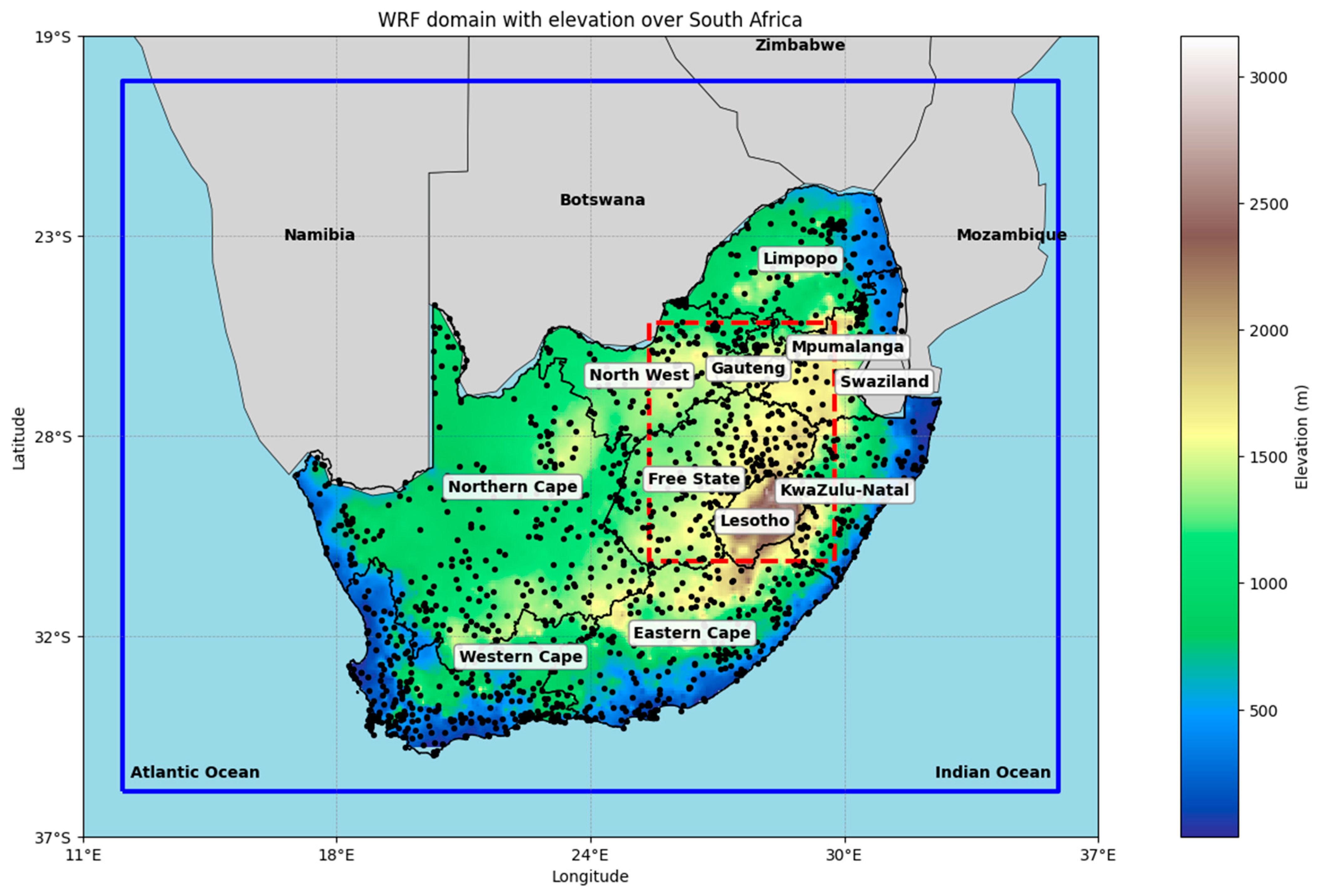
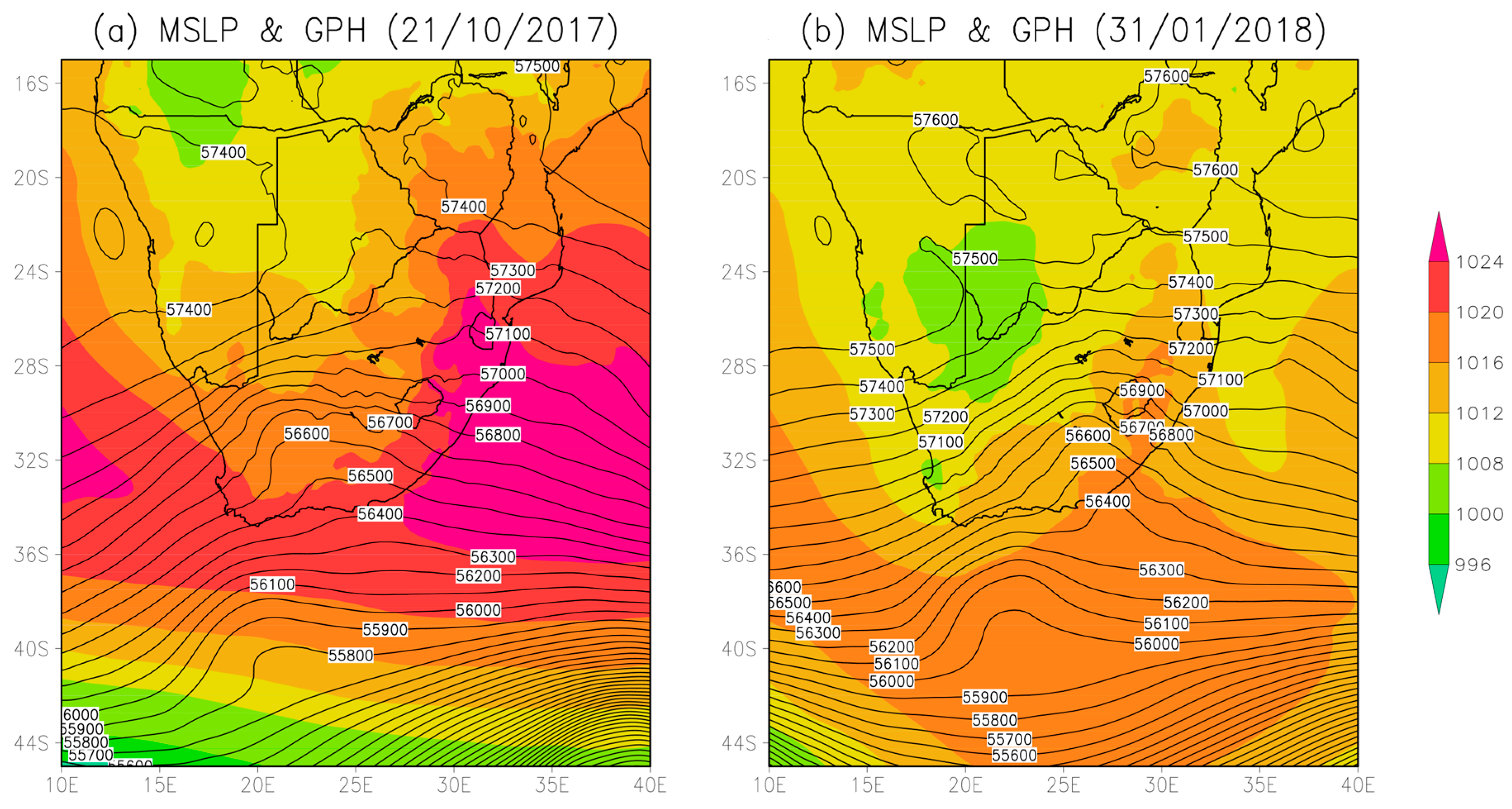
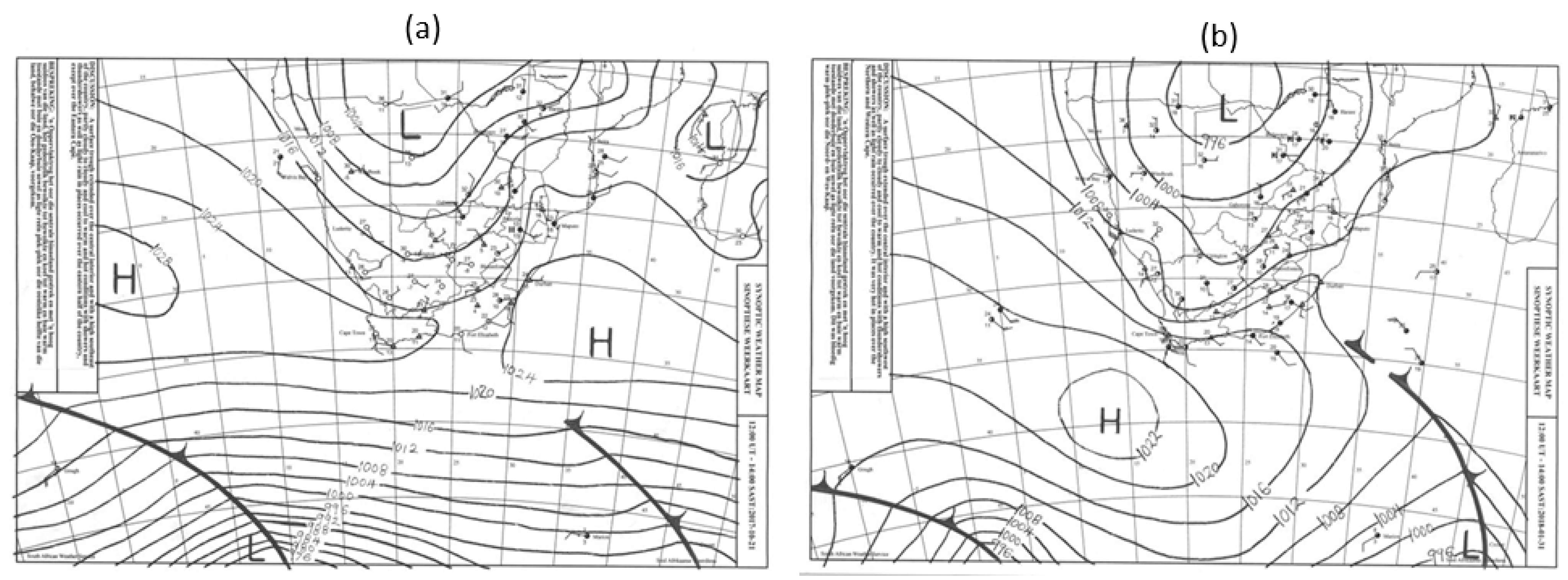

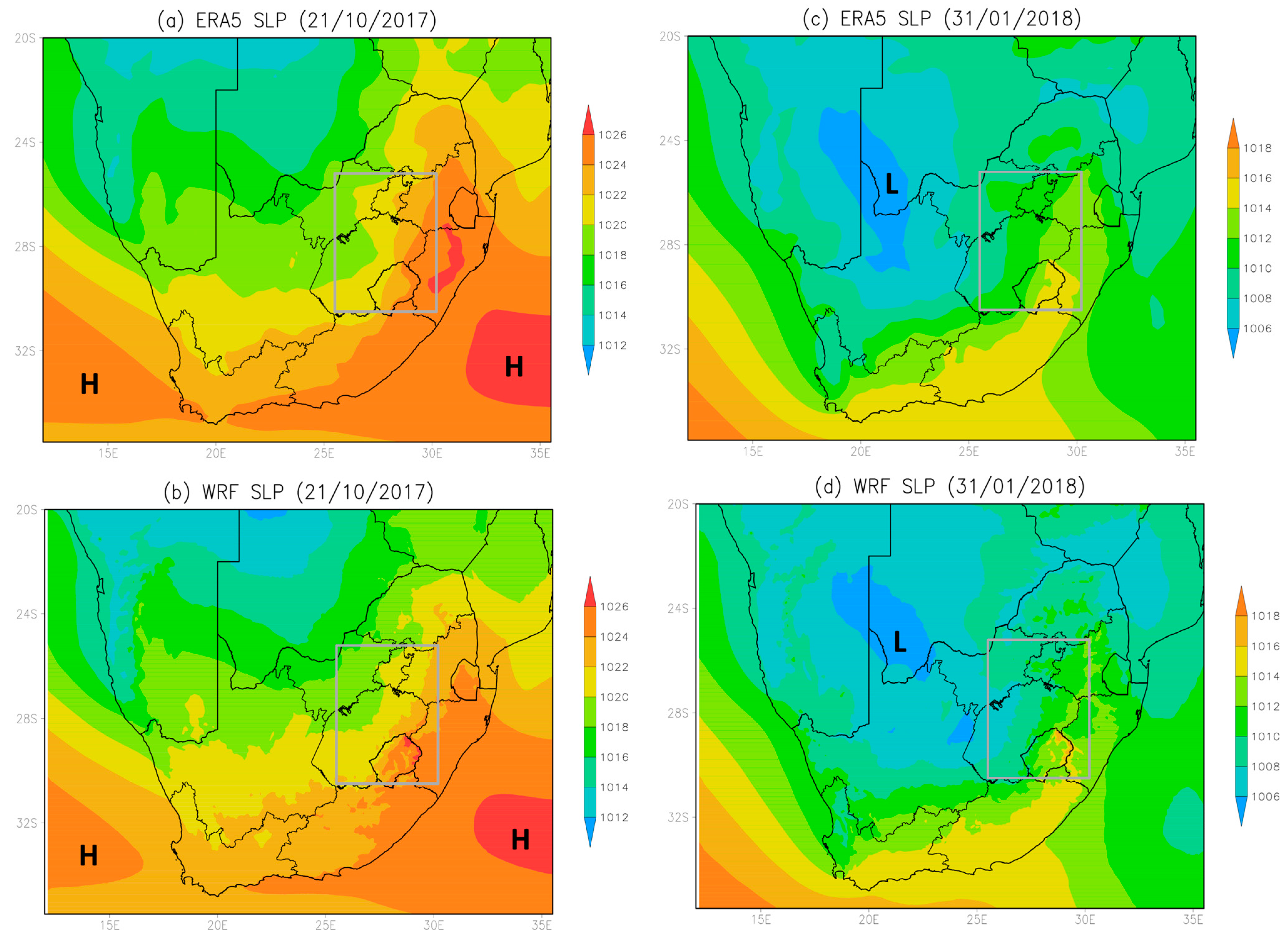
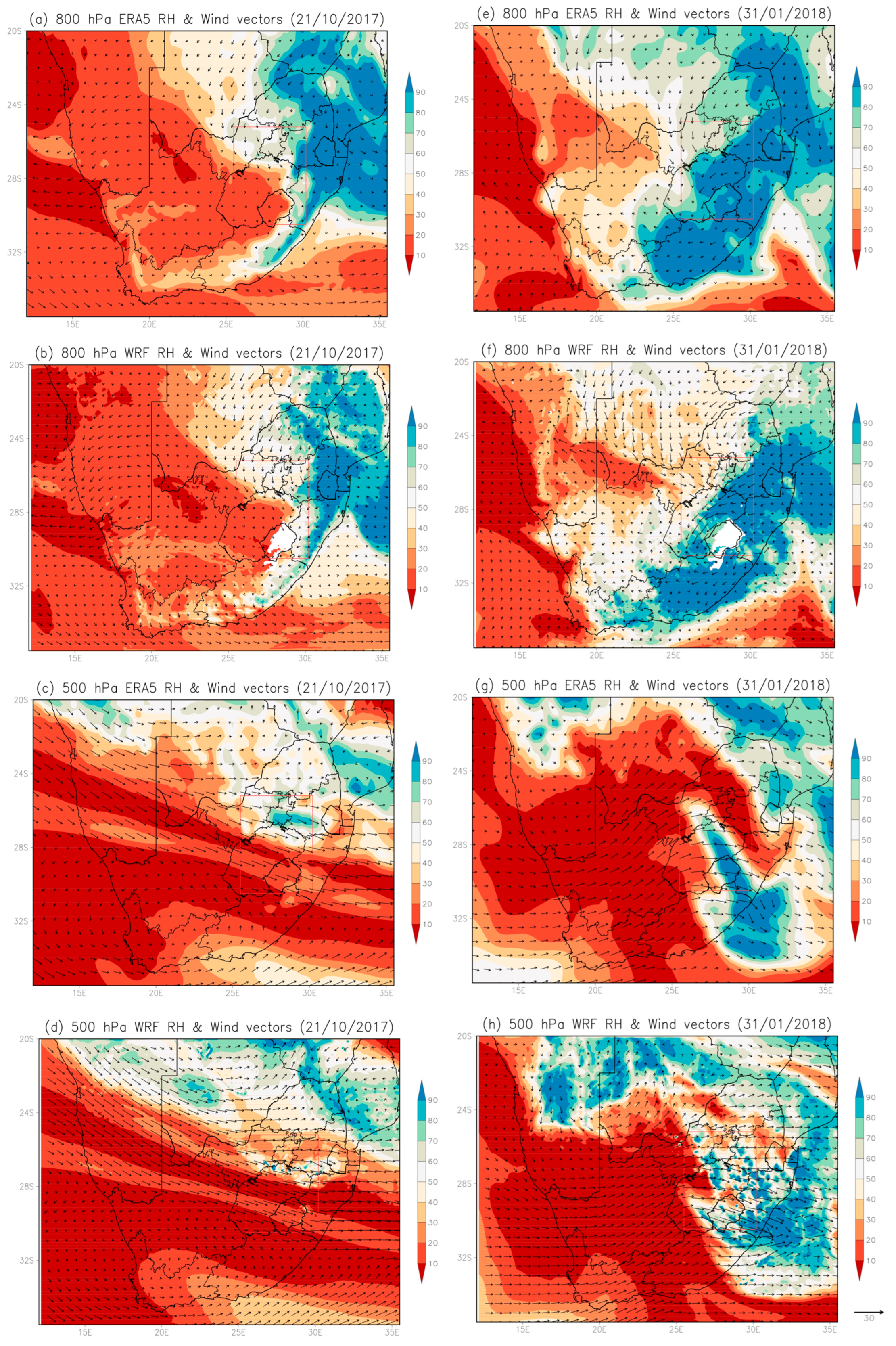
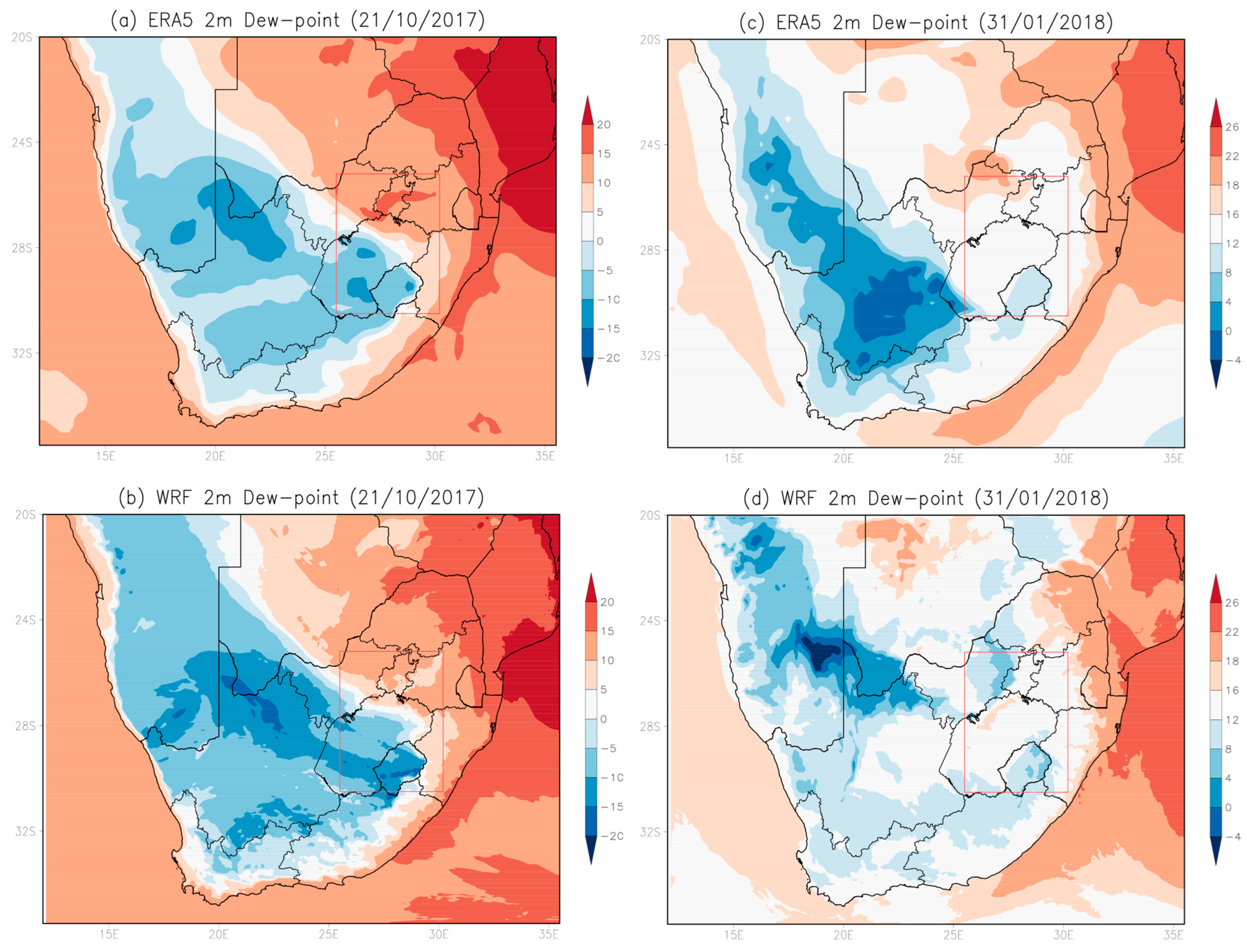
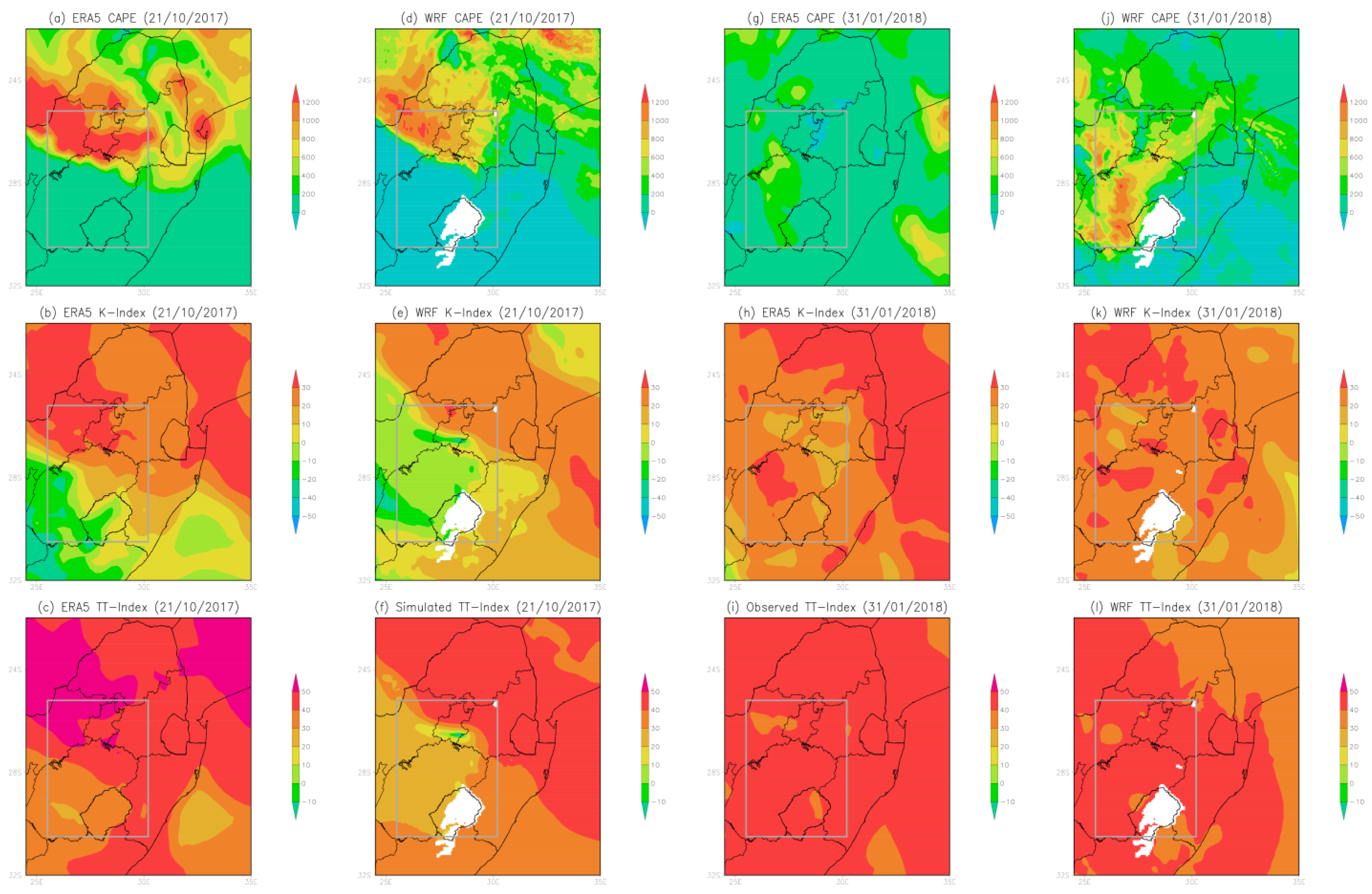
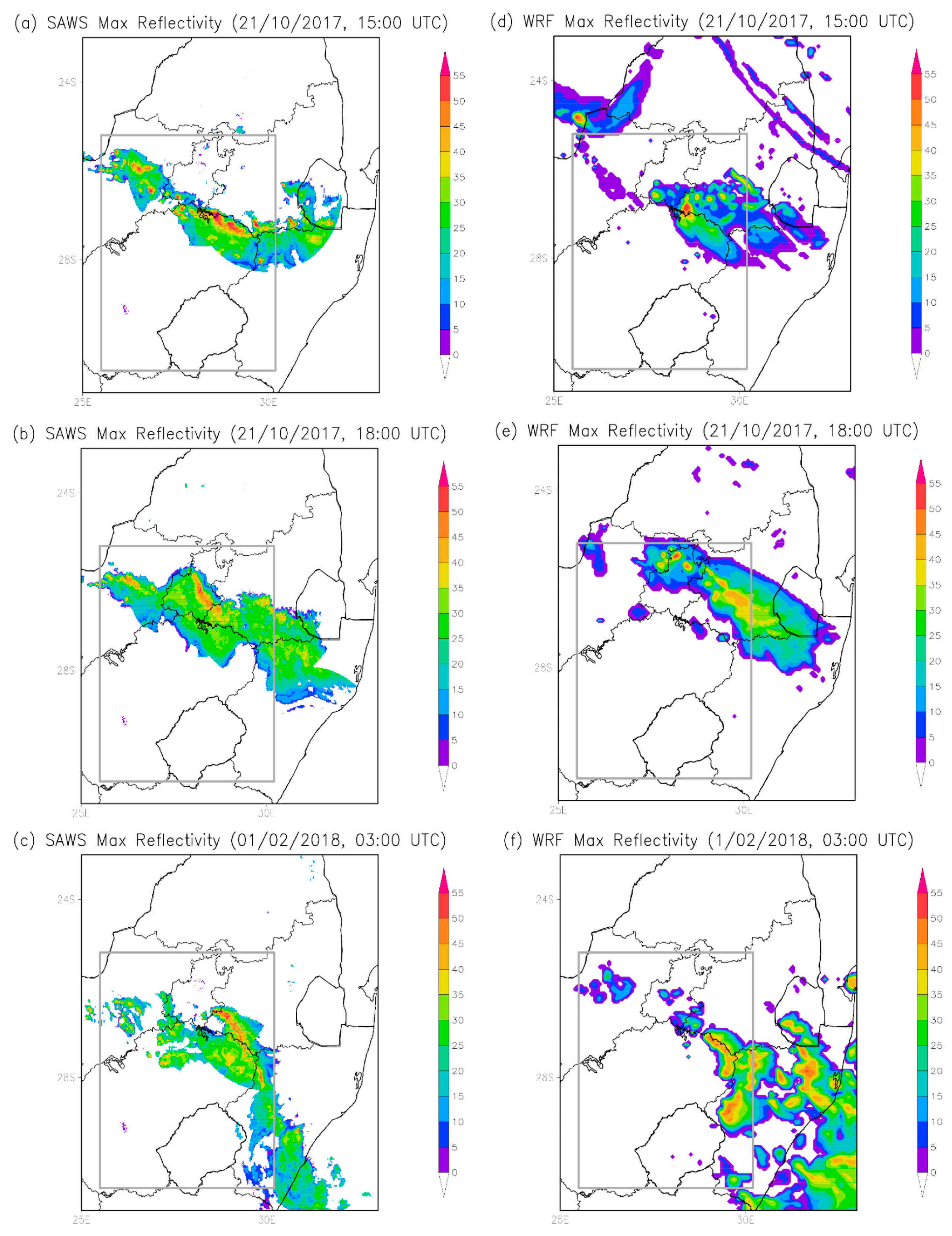
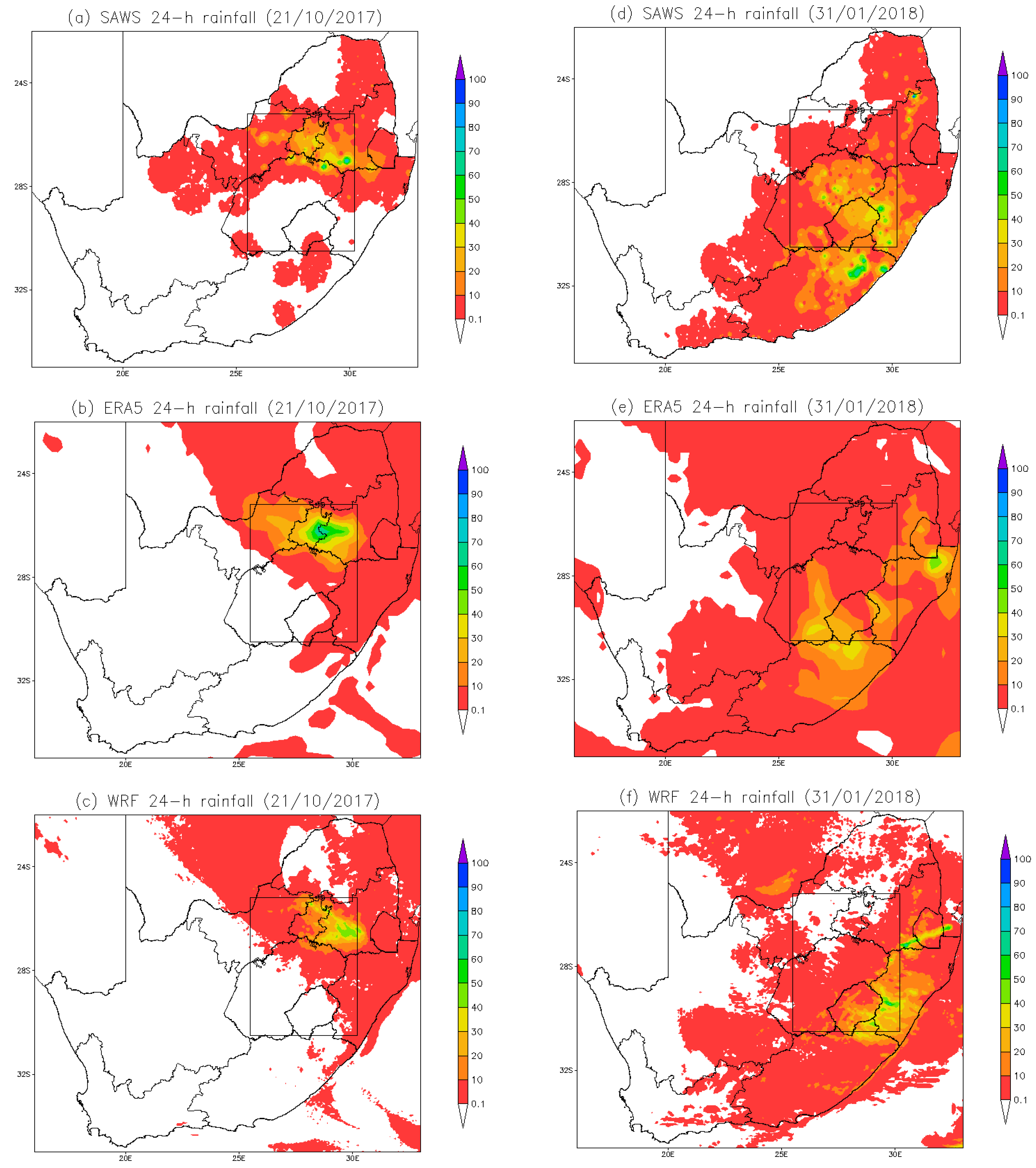
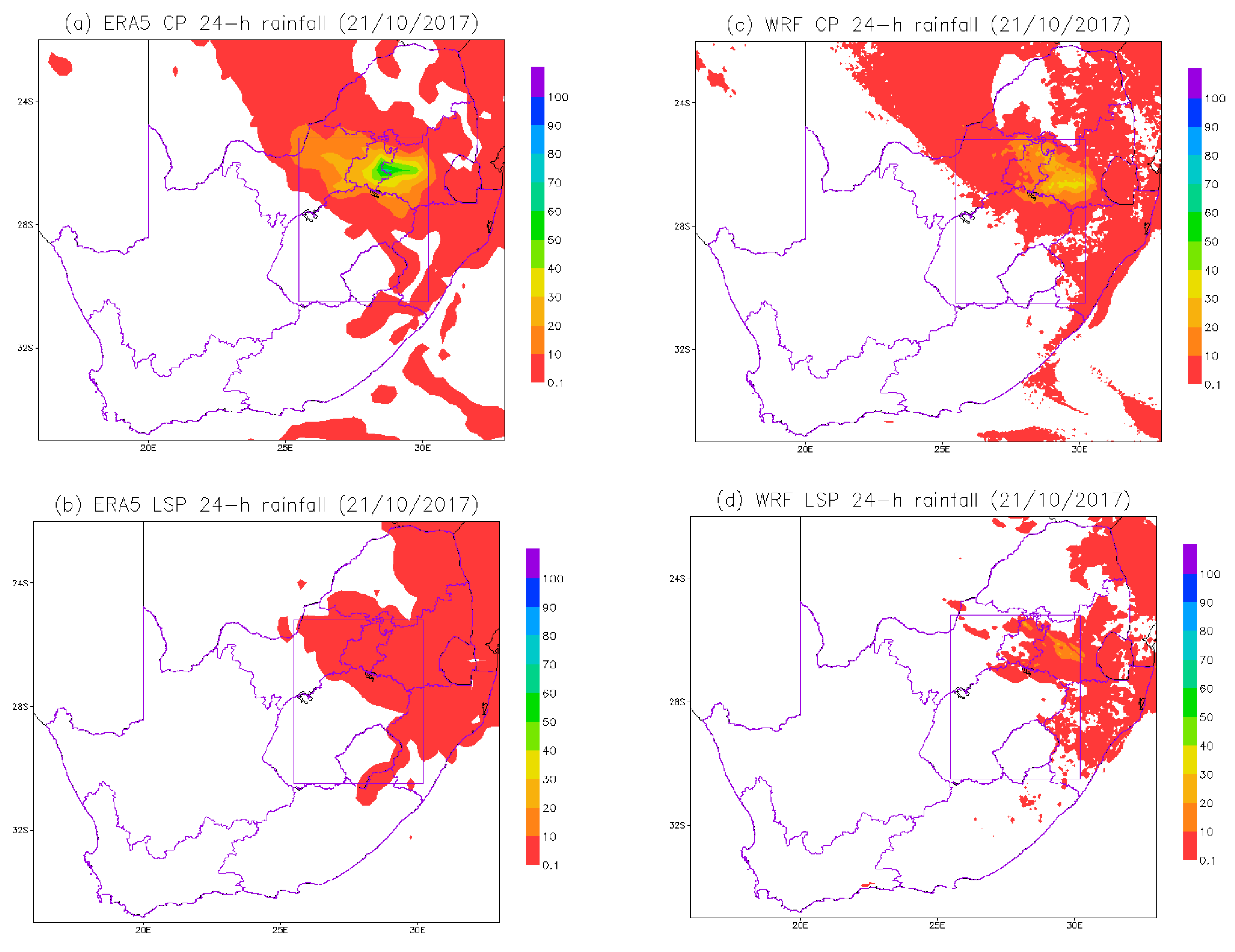
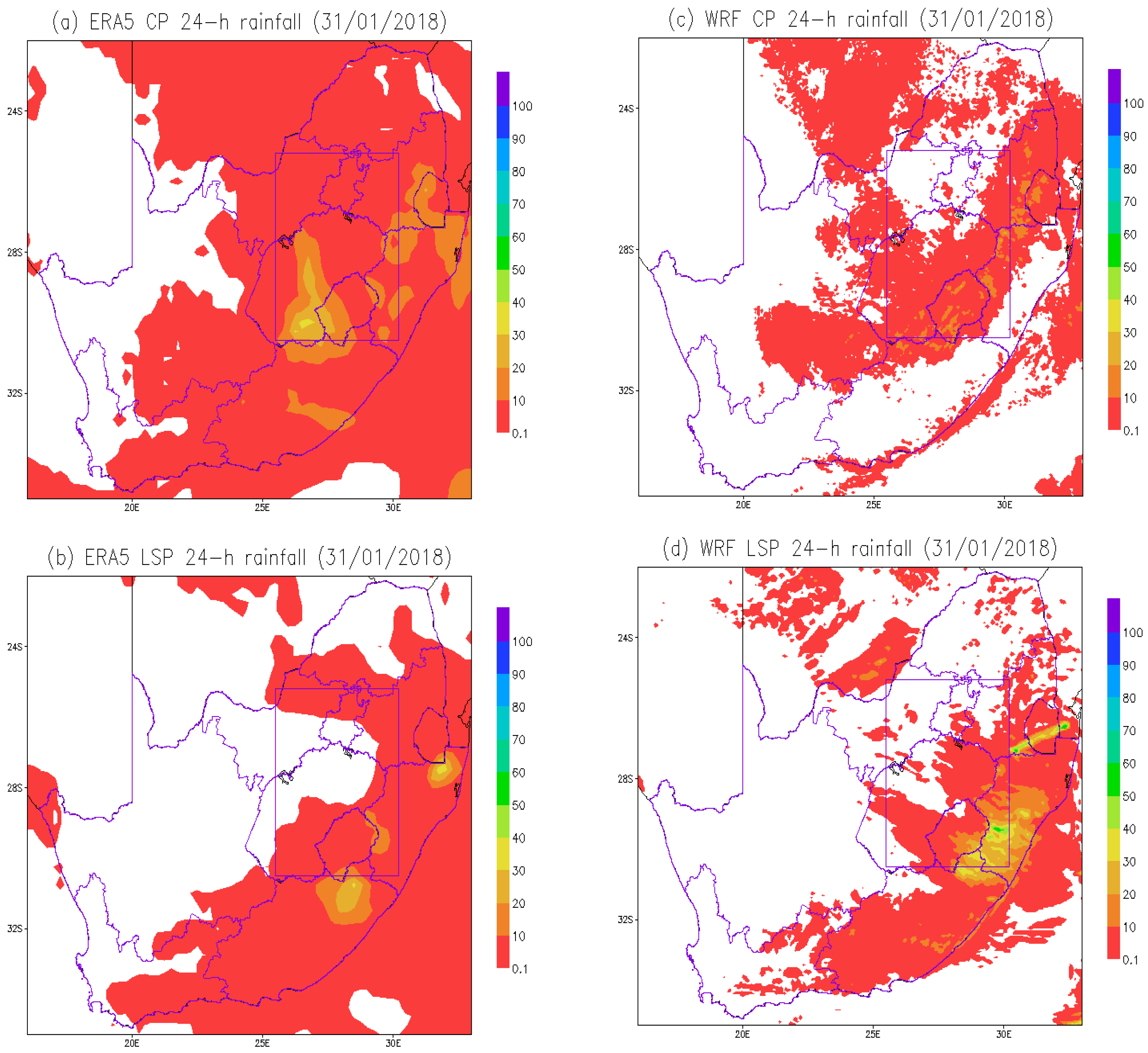
| Event Date | RMSE (mm) | COE | r |
|---|---|---|---|
| 21 October 2017 | 1.959855 | 0.703313 | 0.967335 |
| 1 February 2018 | 12.19444 | −0.61467 | 0.961866 |
| Event Date | Hits | Misses | False Alarms | Bias | TS |
|---|---|---|---|---|---|
| 21 October 2017 | 0.36 | 0 | 0.24 | 1.67 | 0.6 |
| 1 February 2018 | 0.08 | 0 | 0.52 | 7.5 | 0.13 |
Disclaimer/Publisher’s Note: The statements, opinions and data contained in all publications are solely those of the individual author(s) and contributor(s) and not of MDPI and/or the editor(s). MDPI and/or the editor(s) disclaim responsibility for any injury to people or property resulting from any ideas, methods, instructions or products referred to in the content. |
© 2025 by the authors. Licensee MDPI, Basel, Switzerland. This article is an open access article distributed under the terms and conditions of the Creative Commons Attribution (CC BY) license (https://creativecommons.org/licenses/by/4.0/).
Share and Cite
Mbokodo, I.L.; Burger, R.P.; Fridlind, A.; Ndarana, T.; Maisha, R.; Chikoore, H.; Bopape, M.-J.M. Assessing the Performance of the WRF Model in Simulating Squall Line Processes over the South African Highveld. Atmosphere 2025, 16, 1055. https://doi.org/10.3390/atmos16091055
Mbokodo IL, Burger RP, Fridlind A, Ndarana T, Maisha R, Chikoore H, Bopape M-JM. Assessing the Performance of the WRF Model in Simulating Squall Line Processes over the South African Highveld. Atmosphere. 2025; 16(9):1055. https://doi.org/10.3390/atmos16091055
Chicago/Turabian StyleMbokodo, Innocent L., Roelof P. Burger, Ann Fridlind, Thando Ndarana, Robert Maisha, Hector Chikoore, and Mary-Jane M. Bopape. 2025. "Assessing the Performance of the WRF Model in Simulating Squall Line Processes over the South African Highveld" Atmosphere 16, no. 9: 1055. https://doi.org/10.3390/atmos16091055
APA StyleMbokodo, I. L., Burger, R. P., Fridlind, A., Ndarana, T., Maisha, R., Chikoore, H., & Bopape, M.-J. M. (2025). Assessing the Performance of the WRF Model in Simulating Squall Line Processes over the South African Highveld. Atmosphere, 16(9), 1055. https://doi.org/10.3390/atmos16091055







